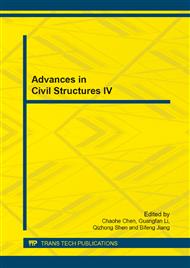p.1290
p.1295
p.1299
p.1302
p.1306
p.1311
p.1317
p.1323
p.1327
Strain Measuring Techniques of the Geogrid
Abstract:
The strain measurement is a most important and absolutely necessary task on the probing into the constitution of the materials. The ways of strain measurement are theoretically divided as the mechanical type, vibrating-string type, inductive type and bonded resistance type, and the last one is widely used for its high precision and convenience. The geogrid, which has been widespread in the reinforcement structures, is more and more popular for its high strength, good toughness, corrosion resistant, anti-fatigue and effective interaction with soil. The geogrid is made of polymer, its ultimate strain can reach above 10%, and it is sensitive to the time, furthermore it usually has significant relative displacement with soil in the tests. Then some measures have to be taken to make the measuring range wider and make the all gauges achieving synchronization, measures also should be conducted to prevent the strain gauges separated from the geogrid when it has slightly bending, prevent the wires break when the gauges going forward and reduce the influences from the forward preventing measures. Some researchers have showed their techniques to avoiding part of the above problems. Based on a series of pullout tests of geogrid, this paper gives the contrast and analysis on those techniques above, and lists the relative measures that used in these tests, especially for the gauge sticking techniques and preventive measures.
Info:
Periodical:
Pages:
1306-1310
Citation:
Online since:
July 2014
Authors:
Price:
Сopyright:
© 2014 Trans Tech Publications Ltd. All Rights Reserved
Share:
Citation:


